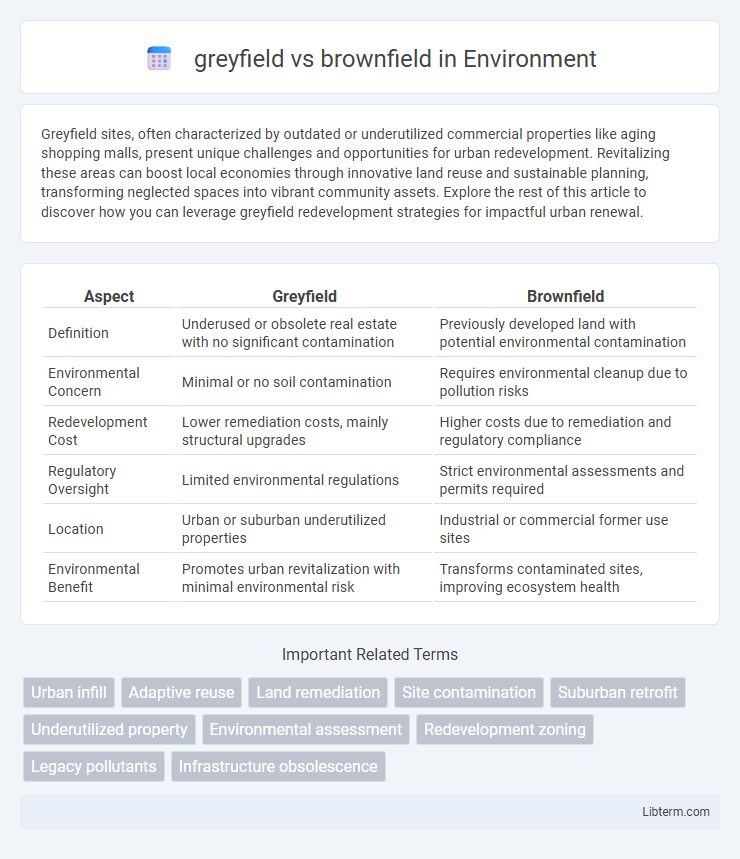Greyfield sites, often characterized by outdated or underutilized commercial properties like aging shopping malls, present unique challenges and opportunities for urban redevelopment. Revitalizing these areas can boost local economies through innovative land reuse and sustainable planning, transforming neglected spaces into vibrant community assets. Explore the rest of this article to discover how you can leverage greyfield redevelopment strategies for impactful urban renewal.
Table of Comparison
| Aspect | Greyfield | Brownfield |
|---|---|---|
| Definition | Underused or obsolete real estate with no significant contamination | Previously developed land with potential environmental contamination |
| Environmental Concern | Minimal or no soil contamination | Requires environmental cleanup due to pollution risks |
| Redevelopment Cost | Lower remediation costs, mainly structural upgrades | Higher costs due to remediation and regulatory compliance |
| Regulatory Oversight | Limited environmental regulations | Strict environmental assessments and permits required |
| Location | Urban or suburban underutilized properties | Industrial or commercial former use sites |
| Environmental Benefit | Promotes urban revitalization with minimal environmental risk | Transforms contaminated sites, improving ecosystem health |
Introduction to Greyfield and Brownfield Sites
Greyfield sites refer to underutilized or obsolete retail properties, such as aging shopping malls, that have lost economic viability but retain functional infrastructure. Brownfield sites are previously developed lands, often industrial, that may be contaminated and require environmental cleanup before redevelopment. Both types of sites present unique challenges and opportunities in urban planning and real estate development, emphasizing the importance of adaptive reuse and sustainable remediation.
Defining Greyfield Redevelopment
Greyfield redevelopment involves transforming underperforming or obsolete commercial properties, such as aging shopping malls, into vibrant mixed-use developments that stimulate economic growth and community revitalization. Unlike brownfield sites, which are contaminated former industrial lands requiring environmental cleanup, greyfields are primarily characterized by economic decline and physical obsolescence without significant environmental hazards. This distinction allows greyfield projects to proceed with lower remediation costs, accelerating redevelopment and urban infill efforts.
Understanding Brownfield Redevelopment
Brownfield redevelopment involves transforming previously industrial or commercial sites contaminated by hazardous substances into usable properties, often requiring environmental cleanup and regulatory compliance. These projects optimize land use in urban areas, reducing urban sprawl while boosting economic revitalization and community development. Successful brownfield redevelopment enhances property values and promotes sustainable urban growth by repurposing underutilized or abandoned sites.
Key Differences Between Greyfield and Brownfield
Greyfield sites refer to underutilized or obsolete commercial properties, such as aging shopping centers, that have lost economic viability, while brownfield sites are previously developed lands contaminated by hazardous substances, requiring environmental remediation before redevelopment. Greyfield redevelopment focuses primarily on revitalizing economically depressed areas without extensive contamination concerns, whereas brownfield projects prioritize cleanup efforts to ensure safety and regulatory compliance. The financial incentives and risk profiles for greyfield projects typically revolve around urban renewal and market repositioning, contrasting with brownfield initiatives that often involve complex environmental assessments and cleanup funding.
Environmental Concerns and Remediation
Greyfield sites typically involve underutilized or abandoned commercial properties with lesser contamination, requiring moderate environmental remediation focused on soil stabilization and minor pollution cleanup. Brownfield sites often present significant environmental concerns, including soil and groundwater contamination from hazardous substances, necessitating comprehensive remediation strategies such as soil excavation, bioremediation, and long-term monitoring. Addressing these environmental challenges on brownfield properties is crucial to mitigate health risks and enable safe redevelopment.
Economic Considerations for Developers
Greyfield redevelopment often attracts developers due to lower acquisition costs compared to brownfield sites, which usually require expensive environmental remediation. Economic incentives such as tax credits and grants are frequently available for brownfield projects to offset cleanup expenses, enhancing their financial viability. Developers weigh these factors alongside market demand and potential return on investment to determine the most cost-effective redevelopment strategy.
Regulatory and Legal Frameworks
Greyfield and brownfield sites differ significantly in regulatory and legal frameworks; brownfield sites are often subject to stricter environmental cleanup laws due to contamination from previous industrial use, requiring compliance with hazardous waste regulations under agencies like the EPA. Greyfield sites, typically underutilized retail or commercial properties, face fewer environmental remediation mandates but must navigate zoning laws, redevelopment incentives, and local planning commission approvals. Understanding these regulatory distinctions is crucial for developers to mitigate legal risks and optimize redevelopment strategies.
Case Studies: Successful Redevelopments
Case studies of greyfield and brownfield redevelopments reveal significant economic and environmental benefits through site-specific approaches. The transformation of Chicago's former industrial brownfield into mixed-use developments demonstrates effective contamination cleanup and community revitalization. Similarly, the repurposing of suburban greyfield sites, like the former mall in Oakbrook, Illinois, highlights adaptive reuse strategies that stimulate local economies and reduce urban sprawl.
Challenges and Opportunities
Greyfield developments face challenges such as outdated infrastructure and lower market appeal compared to brownfield sites, which often require extensive environmental remediation. Brownfield sites provide the opportunity for environmental cleanup and urban renewal but involve higher costs and regulatory complexities. Both present unique opportunities for sustainable redevelopment by repurposing underutilized land and mitigating urban sprawl.
Future Trends in Urban Land Reuse
Future trends in urban land reuse emphasize the growing preference for greyfield development due to its potential for revitalizing underutilized commercial properties with existing infrastructure, reducing new land consumption. Brownfield sites remain critical targets for redevelopment because of their environmental remediation challenges paired with increasing regulatory support and financial incentives. Innovations in sustainable building practices and smart city technologies are expected to enhance the economic viability and environmental benefits of both greyfield and brownfield projects.
greyfield Infographic

 libterm.com
libterm.com